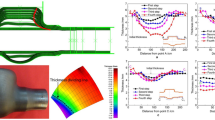Abstract
Tube hydroforming (THF) is a unique forming technique, which can transform metal tubes into complex hollow parts using hydraulic fluid as the forming medium. The initial non-uniform thickness of as-received practical tubes significantly affects their formability in the hydroforming process. A forming limit diagram (FLD), also called as the forming limit curve (FLC), is often adopted to evaluate the forming behaviour of sheet metals in plastic forming processes to avoid forming failures. The purposes of this research are fivefold, namely to establish the FLCs of tubular blanks with varied initial thickness deviations in tensile and compressive strain states by means of finite element (FE) modelling of THF, to construct a non-uniform geometric model for practical tubes, to analyse the impact of initial thickness deviation on the FLCs, to clarify the differences in the FLCs obtained using three different instability criteria, and to validate the proposed non-uniform geometric model by conducting hydro-bulging experiments. Results show that it is possible to accurately predict the FLCs of practical tubes with initial non-uniform thicknesses using FE simulation combined with the proposed non-uniform geometric model. We found that the displacement of FLCs occurred in the major- and minor-strain coordinates because the thickness is initially not uniform; however, no significant discrepancies were observed in the FLCs obtained using the three instability criteria. The proposed approach, which combines FE simulation with a non-uniform geometric model, can be easily employed to predict the ultimate strains of tubes with initial non-uniform thicknesses in THF to avoid forming defects.
Similar content being viewed by others
References
Forouhandeh F, Kumar S, Ojha SN (2015) Recent development of hydroforming-a review. Int J Adv Manuf Syst 15(2):27–36
Pambhar A, Narasimhan K (2013) Prediction of stress and strain based on forming limit diagram during tube hydroforming process. Trans Indian Inst Metals 66(5–6):665–669
Asl YD, Sheikhi M, Anaraki AP, Panahizadeh RV, Gollo MH (2017) Fracture analysis on flexible roll forming process of anisotropic Al6061 using ductile fracture criteria and FLD. Int J Adv Manuf Technol 91(5–8):1481–1492
Mengling W, Guangcheng Z, Zirui G (2017) FEA of vertical parts formed with multistage incremental sheet metal forming based on the forming limit stress diagram. Int J Adv Manuf Technol 93(5–8):2155–2160
Hwang YM, Lin YK, Chuang HC (2009) Forming limit diagrams of tubular materials by bulge test. J Mater Process Technol 209:5024–5034
Kim J, Kim SW, Song WJ, Kang BS (2005) Analytical and numerical approach to prediction of forming limit in tube hydroforming. Int J Mech Sci 47(7):1023–1037
Xianfeng C, Zhongqin L, Zhongqi Y (2011) Prediction of forming limit diagram for seamed tube hydroforming based on thickness gradient criterion. AIP Conf Proc 1383:653–660
Karajibani E, Hashemi R, Sedighi M (2017) Forming limit diagram of aluminum-copper two-layer sheets: numerical simulations and experimental verifications. Int J Adv Manuf Technol 90:2713–2722
Mohammadi M, Karami JS, Hashemi SJ (2017) Forming limit diagram of aluminum/copper bi-layered tubes by bulge test. Int J Adv Manuf Technol 92:1539–1549
Naghibi MF, Gerdooei M, Jooybari MB (2016) Experimental and numerical study on forming limit diagrams of 304 stainless steel tubes in the hydroforming process. J Mater Eng Perform 25(12):5460–5467
Kiuchi M (2005) Inequality of mechanical and geometrical characteristics of steel pipes and their formability. The abbreviation for it is Tetsu to Hagane 18(2):344–347
Kumabara T (2005) Effects of the non-uniformity of steel tubes due to pre-forming history on its free bulging deformation. The abbreviation for it is Tetsu to Hagane 18(2):348–351
Shirayori A, Fuchizawa S, Ishigure H, Narazaki M (2003) Deformation behaviour of tubes with thickness deviation in circumferential direction during hydraulic free bulging. J Mater Process Technol 139(1–3):58–63
Shirayori A, Fuchizawa S, Narazaki M (2005) Influence of initial thickness deviation on tube deformation during free hydraulic bulging. J Meteorol Soc Jpn 44(507):378–381
Yoshida K, Kuwabara T, Kuroda M (2007) Path-dependence of the forming limit stresses in a sheet metal. Int J Plast 23(3):361–384
Dong GJ, Bi J, Du B, Chen XH, Zhao CC (2017) Research on AA6061 tubular components prepared by combined technology of heat treatment and internal high pressure forming. J Mater Process Technol 242:126–138
Hashemi R, Madoliat R, Afshar A (2016) Prediction of forming limit diagrams using the modified M-K method in hydroforming of aluminum tubes. Int J Mater Forming 9(3):297–303
Abed-Meraim F, Balan T, Altmeyer G (2014) Investigation and comparative analysis of plastic instability criteria: application to forming limit diagrams. Int J Adv Manuf Technol 71(5–8):1247–1262
Hu G, Yang L, Liu J (2013) Determination of forming limit diagram for tube hydroforming based on the strain rate change criterion. AIP Conf Proc 1567(1):390–393
Zhalehfar F, Hashemi R, Hosseinipour SJ (2014) Experimental and theoretical investigation of strain path change effect on forming limit diagram of AA5083. Int J Adv Manuf Technol 76(5–8):1343–1352
Yang L, Tang D, He Y (2017) Describing tube formability during pulsating hydroforming using forming limit diagrams. J Strain Analysis for Eng Des 52(4):249–257
Funding
This work was financially supported by the National Natural Science Foundation of China (51564007), Natural Science Foundation of Guangxi Province (2017GXNSFAA198133), and GUET Excellent Graduate Thesis Program under Grant No. 16YJPYSS01.
Author information
Authors and Affiliations
Corresponding author
Additional information
Publisher’s note
Springer Nature remains neutral with regard to jurisdictional claims in published maps and institutional affiliations.
Rights and permissions
About this article
Cite this article
Yang, L., Zhao, Q. Forming limit diagrams for tubes with non-uniform thickness in hydro-bulging. Int J Adv Manuf Technol 103, 901–911 (2019). https://doi.org/10.1007/s00170-019-03596-3
Received:
Accepted:
Published:
Issue Date:
DOI: https://doi.org/10.1007/s00170-019-03596-3




